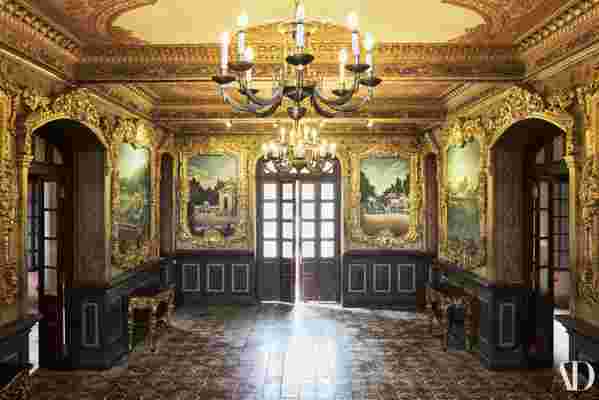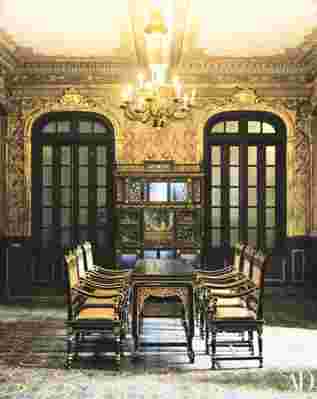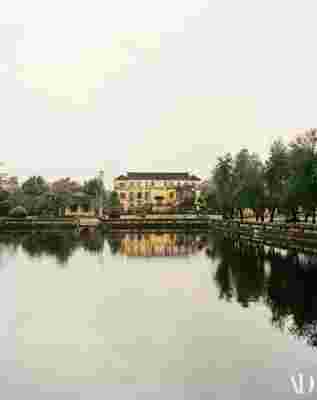When the Duke of Phuong Hoa—young, artistic, sickly—acceded to Annam’s throne in 1916, he took the regnal name Khai Dinh, meaning “augur of peace and stability.” The emperor’s personal taste, though, shook up Hue, the imperial capital. If he had to be the puppet monarch of a French protectorate (today’s Vietnam), then he would do it by synthesizing Sun King swagger with his own cultural traditions. Thus, Cung An Dinh, a captivating pastry of a palace that overlooks the turgid An Cuu Canal.

Murals of Nguyen-Dynasty tombs line the gilded entrance hall.
The three-story mansion’s “mixture of Western coquetry and Annamite art cannot fail to surprise,” a French journalist observed in the 1920s. Nothing has changed. Imperial-yellow façades in Italian Renaissance and neoclassical modes—the architect is yet unknown—bristle with bas-reliefs of bonsai trees. Panicles of rice spring from swags of fruit and foliage. Blossoms resembling Vietnamese natives such as hoa dao, or peach flower, are painted across beams and up stairways. The entrance-hall murals, arguably by French-trained master Le Van Mien, depict Nguyen-dynasty tombs but in European three-dimensional perspective.

Some original furnishings have returned to An Dinh’s rooms; the chandelier, though, is modern.
“Architecture was Khai Dinh’s passion, not ruling,” says German conservationist Andrea Teufel, who, in association with Hue Monuments Conservation Centre, helped restore An Dinh with funding from her country’s Cultural Preservation Program. The big palace that the emperor constructed in the Purple Forbidden City was for living. (For dying, too: He expired there in 1925, at age 40, of spinal tuberculosis.) But comparatively petite An Dinh sits outside the imperial compound. “It was a place for pleasure, to be alone, to meet friends, to play cards,” Teufel says. Records indicate that Khai Dinh preferred same-sex amours, so it was likely a love nest too.

The rear of the villa is mirrored in a vast ornamental pool.
By the time Teufel arrived on the scene, An Dinh was largely ignored because of the emperor’s Francophilia. “To his subjects he was not sufficiently Vietnamese,” she says. Because government-issue paint obscured many of the floral decorations, Teufel’s team of 15 local artists and artisans began a two-year restoration process. Offending layers were removed with scalpels and solvents, and damaged areas were infilled with acrylic paint infused with antifungal agents. Even some original furniture is back.
An Dinh Palace, in Vietnam.
“I didn’t want to train students from Germany. I wanted to train people here, to educate them in restoration techniques,” says Teufel, who is now working full-time on the portal and spirit screen of Hue’s Phung Tien Temple. “There’s still much to be done here, but now they have the knowledge.”
